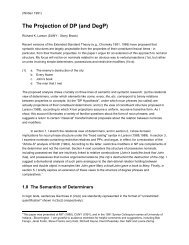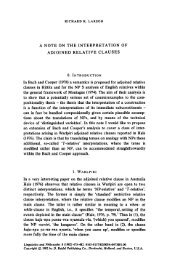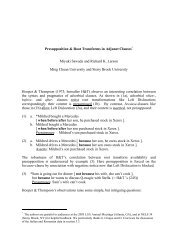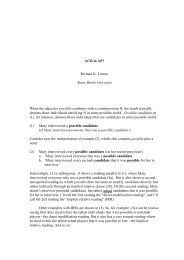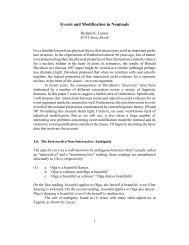Intensional Transitive Verbs and Abstract Clausal Complementation
Intensional Transitive Verbs and Abstract Clausal Complementation
Intensional Transitive Verbs and Abstract Clausal Complementation
You also want an ePaper? Increase the reach of your titles
YUMPU automatically turns print PDFs into web optimized ePapers that Google loves.
<strong>Intensional</strong> <strong>Transitive</strong> <strong>Verbs</strong> <strong>and</strong> <strong>Abstract</strong> <strong>Clausal</strong> <strong>Complementation</strong><br />
1.5 Propositional Anaphora<br />
McCawley (1974) observes that nominal objects of intensional transitives license propositional anaphora.<br />
Thus he points out that the it appearing after allow in (20a) cannot be anaphoric on a horse in the<br />
preceding clause since it does not otherwise agree with the latter in number or gender (cf. (20b,c)):<br />
(20) a. Joe wants a horse, but his mother won’t allow it.<br />
b. Joe wants some horses, but his mother won’t allow it/*them.<br />
c. Joe wants a wife, but his mother won’t allow it/*her.<br />
On the other h<strong>and</strong>, if what follows want is a clausal complement, then the anaphoric relations in (20) are<br />
analogous to those in (21), where it simply refers back to the preceding clause:<br />
(21) Joe wants [PRO to have a horse], but his mother won’t allow it.<br />
(cf. Joe wants to have a horse, but his mother won’t allow Joe to have a horse.)<br />
2.0 The Syntax of Non-finite <strong>Clausal</strong> Complements<br />
The concealed clause analysis clearly has empirical motivation, <strong>and</strong> also has the virtue of reducing<br />
unexpected properties of apparent transitive constructions with want, need, imagine, etc. to the expected<br />
properties of clausal complement constructions with the same verbs. At the same time, however, the<br />
analysis raises a large number of syntactic issues. We are immediately faced with the question of what<br />
form concealed complement clauses take, <strong>and</strong> what principles license their parts. Furthermore, we have<br />
to face some divergences in the behavior of intensional transitives <strong>and</strong> their overt clausal counterparts.<br />
For example, if "objects" of intensional transitives arise in a complement clause, then why can they be<br />
passivized when their overt clausal counterparts cannot?<br />
(22) a. Crackers are preferred/wanted/desired/hoped for.<br />
b. *John is preferred/wanted/desired/hoped for to leave.<br />
To address these issues, we begin by examining the analysis of overt nonfinite complements, with<br />
particular attention to the issue of Case assignment.<br />
2.1 ECM Complements (Lasnik & Saito 1991, Lasnik 1993)<br />
In recent work, Lasnik & Saito (1991) <strong>and</strong> Lasnik (1993) propose an interesting account of ECM<br />
constructions like (23a) that captures some aspects of the "raising to object" analysis defended by Postal<br />
(1970). The authors propose that (23a) involves a covert raising operation in which the subject him of the<br />
embedded clause (Agr s P) moves to Spec Agr o where accusative Case is checked (23b). Thus although<br />
the embedded subject never becomes a thematic object of believe, it does become an object with respect<br />
to Case:<br />
7



